Located at the Sangachal Terminal in Azerbaijan, the plant removed over 97% of chemical oxygen demand and over 99% of several organic contaminants.
Arnold Zilverentant and Adriaan van Nieuwkerk, DHV BV; Ian Vance, Centromere Limited; Annette Watlow, BP Exploration; and Matthew Rees, Azerbaijan International Operating Company
An aerobic, submerged-filter membrane bioreactor was used to treat produced water from offshore oil reservoirs at up to 4.7 bpd. Despite the high salinity (2–5% total dissolved solids) and Chemical Oxygen Demand (COD, up to 50,000 mg/L), the produced water was effectively treated, with reductions of greater than 97% in COD, and greater than 99% for specific organic components such as aliphatic hydrocarbons, monoaromatic hydrocarbons, aliphatic acids, aromatic acids and Polycyclic Aromatic Hydrocarbons (PAHs). In general, metal removal during treatment was limited. Exceptions were iron, manganese and barium, of which more than 90% was removed.
Reversible fouling of the membrane filter was observed in response to changes in flux rates and mode of operation. Permeability was restored by in situ cleaning at pH 2–2.5, followed by an oxidative treatment using sodium hypochlorite. The Membrane BioReactor (MBR) appeared to be well suited to produced water duty. Despite a very high degree of removal of organics, the effluent COD was greater than the target 250-mg/L discharge specification.
INTRODUCTION
The Sangachal Terminal, located 55 km south of Baku, Azerbaijan, sits at the head of the Baku-Tiblisi-Ceyhan (BTC) oil export line. The 1,768-km BTC pipeline is the second-longest oil pipeline in the world, crossing Azerbaijan, Georgia and Turkey, terminating at the Ceyhan Marine Terminal on the southeastern Mediterranean coast of Turkey. The pipeline has a capacity of 1 million bopd. The Sangachal Terminal receives production from the Azeri-Chirag-Guneshli (ACG) and Shah Deniz offshore production facilities. The first production from an early oil project reached the terminal in December 1997, and in February 2002 the Sangachal Terminal Expansion Project was initiated.
Initially, produced water at the terminal was utilized as process water in a nearby cement production facility, but as produced water volumes increased, alternative treatment and disposal schemes were evaluated, including treatment by a membrane bioreactor. This technology combines a membrane process such as microfiltration or ultrafiltration with a suspended growth bioreactor, and is widely used for municipal and industrial wastewater treatment. The MBR option was assessed over 4 months to evaluate the impact of anticipated fluctuations in produced water composition.
Biological treatment had previously been shown to be effective on produced water. For example, a pilot-scale (up to 11 bpd) plant demonstrated more than 99% removal of total petroleum hydrocarbons from produced water with a Total Dissolved Solids (TDS) concentration up to 57,000 mg/L.1 The full-scale treatment of produced water in Sumatra (with a predicted peak flow of 25,000 bpd), using activated sludge technology, reduced Biochemical Oxygen Demand (BOD) and COD concentrations by 90%.2 Biological treatment in the form of a wetland system treating 35,000 bpd of produced water in the United States has been shown to meet all discharge limits.3 In some cases, where the produced water’s Total Organic Carbon (TOC) is relatively low (32.7 mg/L), biological treatment and discharge has been shown to be a cheaper option than disposal by re-injection.3
Although some produced waters are amenable to biological treatment, it was anticipated that produced water with a high salinity and high TOC would be difficult to treat in a conventional biological process plant. An MBR appeared to be suitable, because high sludge densities could be achieved and separation difficulties associated with highly saline water could be avoided by membrane filtration of the effluent. MBRs have successfully treated a range of industrial wastewaters such as those from textile, paper and dye industries4 and automotive and tank cleaning.5 MBRs have been shown to reduce the concentration of oil and surfactants in non-saline wastewater by 99%.6 Experience with highly saline effluents from the tanning industry suggests that MBRs would be particularly suitable for treating saline produced water.7 The potential of MBR technology for treating produced water was assessed in fouling studies using a synthetic mixture as an influent. This study reported 95% reduction in COD; however, a 50% decrease in membrane permeability was noted when compared with treating municipal wastewater.8 We are unaware of any published field experience in treating oilfield produced water in an MBR.
MATERIALS AND METHODS
Produced water from offshore oil production platforms was piped onshore in pipelines containing the produced water, oil and gas. Onshore, gravity separation of the water phase was achieved in heater-treaters, and the separated water was stored in tanks prior to disposal. Sub-samples of stored produced water (about 6 bbl) were transferred as required to a day tank holding the influent for the MBR.
MBR pilot plant. The MBR pilot plant built by DHV had a 35-bbl capacity and operated with a recycle feed rate of 5 bpd, Fig. 1. An oily-water interceptor was placed upstream of the MBR unit to remove free oil from the influent. The produced water was aerated in the anti-bulking reactor upstream of the MBR to improve the MBR’s operability.
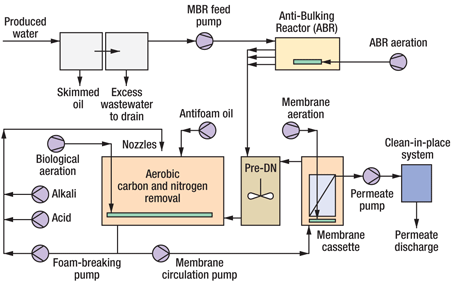 |
|
Fig. 1. Schematic diagram of the pilot plant.
|
|
The submerged filter was a full-scale, low-pressure membrane module comprised of reinforced hollow-fiber, ultra-filtration membranes arranged in a cassette of three elements with a total surface area of 495 sq ft.
Membrane permeate was returned to the bioreactor system from the permeate tank if the tank level was low, or was discharged when the tank level reached its high-level set point. Under these conditions, the system throughput was controlled by the feed pump speed and bioreactor level, rather than the clarification throughput.
Commissioning and startup. Because of produced water’s high salinity and COD, steps were taken to acclimate the biomass to the imposed operating conditions. The plant was initially filled with water from the Caspian Sea (12.8 g/kg TDS) and seeded with 10 L of biomass from a laboratory reactor that had shown successful biological treatment of the produced water. The laboratory reactor was originally seeded with sludge from a municipal wastewater treatment plant that had been slowly adapted to the high salinity of the produced water over a period of 2 months. Once the MBR plant was operational, it was fed produced water at a low rate (1.3–3.1 bpd). A relatively high residence time (11 days) was used to facilitate a gradual adaptation to the produced water, while still maintaining an acceptable Food-to-Microorganism (F/M) ratio.
Steady-state operation. The plant was fed with a number of batches of produced water. The COD concentration of each batch was measured and the feed flow was adjusted to maintain the required F/M ratio. As a result, the feed flowrate varied between 10 and 30 L/hr. The permeate flux was normally 600 L/hr. Accordingly, at least 95% of the permeate was recycled through the unit. This very high recycle ratio resulted from the unexpectedly high influent COD concentration.
The dissolved oxygen concentration was controlled at a value between 1.5 and 2.5 mg/L by using fine bubble aeration. The pH and temperature inside the MBR were monitored, but not controlled. Urea and phosphoric acid were added as necessary to balance the nutrient status of the influent.
Membrane cleaning. When membrane cleaning was required, appropriate chemicals were added to the permeate tank, to allow in situ cleaning. Cleaning in air was also performed at irregular intervals. After initial trials with hydrogen peroxide (H2O2), all further cleaning was carried out at pH 2–2.5, followed by an oxidative cleaning regime using sodium hypochlorite (NaOCl), at a range of concentrations and durations. At the end of the 5-month test period, an extensive cleaning regime was performed to evaluate any irreversible fouling.
Production chemicals. Since the produced water came from a fully operational process, it contained the water-soluble portion of the production chemicals in current use. In order to assess the possible impact of future changes in production chemical use, the day tank was amended with additional production chemicals at concentrations predicted to be the maximum dose at any point in field life. Hydrate inhibitor (methanol, 500 ppm), demulsifier (86 ppm), antifoam (43 ppm), corrosion inhibitor (170 ppm), wax inhibitor (270 ppm) and scale inhibitor (9 ppm) were added to the day tank, and the effects on plant performance were recorded. The chemical spiking contributed about 3,000 mg/L to the total COD of the wastewater.
RESULTS AND DISCUSSION
At the time of the pilot trial, the development of the oil fields was at a very early stage. The produced water flow at that time was only a fraction of the volume anticipated in the future. As a result of the relatively long storage time, the produced water cooled down to about ambient temperature. During the pilot plant startup under winter conditions, and with limited biological heat production, the temperature in the pilot plant was relatively low (average 15°C). Three months later, the average temperature had increased to 27°C (Fig. 2), owing to rising ambient temperatures and increased heat generation from biological activity. Once the fields are in full production, the temperature of the produced water in the storage tank will be higher than ambient, and cooling prior to biological treatment will become necessary.
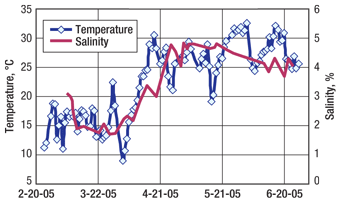 |
|
Fig. 2. Operating temperature and influent salinity.
|
|
The increase in the influent salinity from about 2% TDS to 4–5% corresponded with the observed temperature increase, Fig. 2. This is considered to be coincidental and is an example of the variability expected in the composition of produced water. This is particularly true where the water is produced from multiple subsurface horizons from multiple wells that produce fluids at different rates depending upon reservoir management requirements.
Sludge concentration and F/M ratio. Upon startup, the aim was to reach a Mixed Liquor Suspended Solids (MLSS) value in the bioreactor of at least 10,000 mg/L in 4–6 weeks. This was achieved, and the MLSS was allowed to increase over the following 3 months and was maintained at 20,000 mg/L. Toward the end of the trial, MLSS peaked at 25,000 mg/L, but this was not found to be detrimental to overall plant performance.
After measuring the COD concentration of each batch of produced water added to the MBR, the influent flow was adjusted to maintain an F/M ratio of 0.2 (measured as influent COD divided by MLSS). Figure 3 shows how the F/M ratio varied with time. At the beginning and middle of the trial, the plant was operating at higher values of F/M ratio than the target. This substantial increase appeared to have little or no effect on the effluent quality.
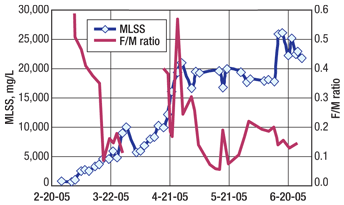 |
|
Fig. 3. Specific oxygen uptake rate and F/M ratio during production chemical amendment.
|
|
Removal of COD. The influent COD concentration (up to 50,000 mg/L) is unusually high for produced water, which according to a 1992 study typically has values up to 2,070 mg/L.9 Total COD and soluble COD values were very close throughout the trial, indicating that little of the COD exists as suspended solids.
The influent COD also proved to be highly variable, ranging from 4,000 to 50,000 mg/L, but biological treatment at high salinity did not pose insurmountable problems. Under steady-state conditions, the COD removal efficiency was, in general, greater than 97%. This is similar to the performance reported for a synthetic produced water that had methanol as a major component.8 However, despite the high removal efficiency, the high COD of the influent resulted in an effluent COD typically between 1,000 and 2,000 mg/L. The treated effluent did not meet the World Bank industry sector guidelines for petroleum refining of 150 mg/L or the general environmental guidelines of 250 mg/L.
Removal of organics. The produced water contained a complex mixture of organics, and all of those analyzed showed some degree of removal during treatment in the MBR, Table 1. In general, the removal of organic compounds was high (greater than 94%). The produced water contained a relatively high concentration of aliphatic aids, the most abundant of which was 3-methylbutanoic acid (2,200 mg/L). The concentration of naphthenic acids was also high, with cyclopentane carboxylic acid and cyclohexane carboxylic acid both being present at 1,000 mg/L. All of the acids were effectively removed during treatment by greater than 99%. Out of the aromatic components (27 mg/L), only a very low concentration of benzene (0.0019 mg/L) was analyzed in the effluent. The removal of BTEX (99.9%) was the same as that reported for a synthetic produced water containing 33 mg/L of BTEX.8
| TABLE 1. Major organics and metals in produced water and their removal efficiency in the MBR |
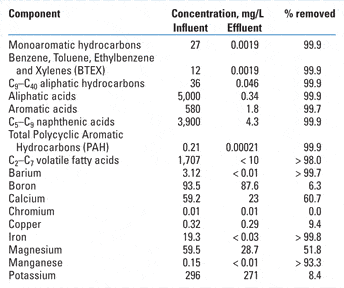 |
Removal of metals. Heavy metals were in general only present at very low concentrations, mostly even below the detection limit, Table 1. Removal of metals was limited. A notable exception was iron, of which 99.8% was removed during treatment. Over 70% of the total iron was present in particulate form, so removal by the membrane filter would be expected to be high. Similarly, removal of over 90% of barium and manganese was achieved; these were also present mainly in the insoluble state (96% and 93%, respectively). The limited removal of calcium and magnesium was probably due to precipitation as carbonate, produced through the biological conversion of organics.
Membrane performance. The performance of the hollow-fiber membranes was measured and assessed during three different operating conditions summarized in Table 2. Predictably, fouling of the membrane was observed during the trial, but this did not result in permanent damage. The effect of fouling was reversed by routine cleaning. Generally, the permeability of the membranes declined with time, Fig. 4. A steady decline of up to 80% permeability was observed over 25 days for Period 1. The loss of permeability was less apparent (only 20% over 15 days) for Periods 2 and 3.
| TABLE 2. Operating conditions during membrane fouling assessment periods |
 |
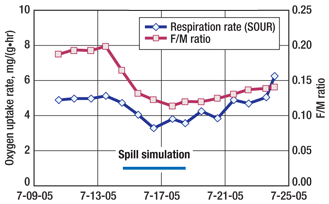 |
|
Fig. 4. Membrane permeability decline under different operating conditions.
|
|
Permeability was enhanced by operating with a reduced flux rate, achievable by a lower feed rate or introduction of a membrane relaxation period. The permeability of the membrane at equivalent flux rates was generally lower than that described for a system treating synthetic produced water.8 The pilot plant, however, was treating real produced water with a COD over 50 times higher than the synthetic mixture and was operating with an MLSS concentration up to 3.3 times higher. The results from the pilot plant are encouraging, showing that effective membrane operation can be maintained under realistic operating conditions, tending toward the worst case, using routine cleaning to restore membrane permeability. Membrane lifetimes are expected to be at least 2–3 years.
Effect of production chemicals. Some production chemicals have biocidal or biostatic properties, so an evaluation of possible deleterious effects upon plant operation was carried out by dosing the proposed production chemicals at their maximum predicted concentration at any point in field life. This was deemed a worst-case scenario since maximum dosing of all production chemicals would not necessarily coincide.
The amendment with production chemicals appeared to initially depress the Specific Oxygen Uptake Rate (SOUR), as shown in Fig. 3. The SOUR then remained about 40% lower than the rate prior to amendment. The amendment with production chemicals, however, coincided with a substantial decrease in the F/M-loading rate (Fig. 3), which normally also results in a drop in the SOUR. With increasing F/M ratio, the SOUR also increased. The impact of the production chemicals on the MBR performance is therefore considered to be limited. Any seriously negative effects of deliberately added process chemicals could be minimized by careful selection and testing programs prior to their deployment for routine use.
Potential for reuse. In terms of high salinity and COD, the composition of the produced water is viewed as a worst case. Even after successful treatment, the salinity remained high, which precluded options for reuse in the absence of a suitable diluent. The treated effluent COD was also too high for uses such as irrigation.
In addition, the concentration of boron was high enough that it alone would preclude use for irrigation. Additional treatment, such as reverse osmosis, would be required in order to comply with water quality specifications for irrigation. In fact, further treatment would be required to meet a 250-mg/L COD standard for discharged water if applied at the end of the pipe. Initial testing using nanofiltration showed a substantial additional COD removal at a recovery of more than 90%.
CONCLUSIONS
Despite the high and fluctuating values of COD and salinity in the produced water influent (up to 50,000 mg/L), successful treatment was carried with the MBR. Removal rates of more than 97% for COD and more than 99% for aliphatic hydrocarbons, monoaromatic hydrocarbons, aliphatic acids, aromatic acids, naphthenic acids and PAH were achieved.
Despite the high removal rates, the high COD concentration of the influent resulted in an effluent COD that was higher than the 250-mg/L discharge standard. 
ACKNOWLEDGMENTS
The authors thank the Azerbaijan International Operating Company and partners in Azeri, Chirag and Guneshli Fields for permission to publish this work.
LITERATURE CITED
1 Tellez, G. and N. Khandan, N., “Biological treatment processes for removing petroleum hydrocarbons from oilfield produced waters,” in Reed, M. and S. Johnson, eds., Produced Water 2: Environmental Issues and Mitigation Technologies. Environmental Science Research, Volume 52, Plenum Press, New York, 1996, pp. 499–597.
2 Madian, E.S ., Moelyodihardjo, T., Snavely, E. S. and R. J. Jan, “Treating of produced water for surface discharge at the Arun gas condensate field,” SPE 28946 presented at the SPE International Symposium on Oilfield Chemistry, San Antonio, Texas, Feb. 14–17, 1995.
3 Myers, J. E., Jackson, L. M., Bernier, R. F. and D. A. Miles, “An evaluation of the Department of Energy Naval Petroleum Reserve No. 3 produced water bio-treatment facility,” SPE 66522 presented at the SPE/EPA/DOE Exploration and Production Environmental Conference, San Antonio, Texas, Feb. 26–28, 2001.
4 Marrot, B., Barrios-Martinez, A., Moulin, P. and N. Roche, “Industrial wastewater treatment in a membrane bioreactor: A review,” Environmental Progress, 23, No. 1, 2004, pp. 59–68.
5 Lawrence, D., Van Gool, H. and A. Zilverentant, “Potentials for MBR in industry,” H2O, MBR Special II, 2003, pp. 13–15.
6 Scholz, W. and W. Fuchs, “Treatment of oil contaminated wastewater in a membrane bioreactor,” Water Research, 34, No. 14, 1999, pp. 3621–3629.
7 Scholz, W. G., Rouge, P., Bodalo, A. and U. Leitz, “Desalination of mixed tannery effluent with membrane bioreactor and reverse osmosis treatment,” Environmental Science & Technology, 39, No. 21, 2005, pp. 8505–8511.
8 Brookes, A., Jefferson, B., Le Clech, P. and S. J. Judd, “Fouling of membrane bioreactors during treatment of produced water,” paper 074 presented at the International Membrane Science and Technology Conference, Sydney, Australia, Nov. 10–14, 2003.
9 Tibbets, P. J. C., Buchanan, I. T., Gawel, L. J. and R. Large, “A comprehensive determination of produced water composition,” in Ray, J. P. and F. R. Engelhardt, eds., Produced Water Technological/Environmental Issues and Solutions. Environmental Science Research, Volume 46, Plenum Press, New York, 1992, pp. 97–112.
|
THE AUTHORS
|
| |
Arnold Zilverentant is a Senior Specialist at DHV on water and wastewater treatment, with involvement in process design, engineering and research projects. With almost 30 years of experience as a wastewater treatment and process engineer, he has carried out numerous projects in Europe and overseas. He has an MSc degree in chemical engineering.
|
|
| |
Adriaan van Nieuwkerk has MSc degrees in chemical engineering and management science. He has more than 30 years of experience with industrial water treatment projects in various countries. As an Account/Project Manager of DHV Water, Mr. van Nieuwkerk is responsible for the realization of industrial water treatment projects.
|
|
| |
Ian Vance has a BSc degree in biological sciences and a PhD degree in marine microbial ecology. After three years as a research fellow working in fermentation technology, he joined the New Technology division of BP, specializing in the microbiological conversion of cellulose to ethanol. He then worked on many diverse projects for BP. He now operates an independent consultancy specializing in microbiological water treatment and environmental issues.
|
|
| |
Annette Watlow is an Environmental Engineer with BP, working to increase energy efficiency and reduce environmental impact of company projects in the early design stages. She has an engineering degree and an MBA and has 29 years experience in the oil and gas industry.
|
|
| |
Mathew Rees has an engineering degree and holds an MA from Cambridge University. He has 20 years of experience working in the oil and gas industry. He has worked for BP as a Project Manager since 2001 on various projects related to ACG Field in Azerbaijan. He currently oversees brownfield modification and upgrade work on the six offshore facilities operated by BP in the Caspian Sea.
|
|








